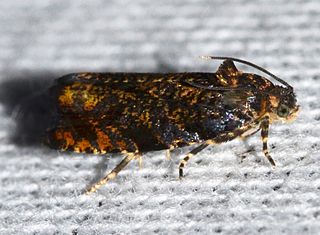
Sematurinae is a subfamily of moths in the family Sematuridae represented by at least 29 species in the Neotropics.

Eugauria is a genus of moths of the family Crambidae. It contains only one species, Eugauria albidentata, which is found on Java.
Afrophyla is a monotypic moth genus in the family Geometridae described by Warren in 1895. Its only species, Afrophyla vethi, was first described by Snellen in 1886. It is found in eastern Africa.
Altrivalvina is a genus of moths in the family Geometridae. Its only species, Altrivalvina magnifica, was described from Yunnan, China. Both the genus and species were described by Wehrli in 1939.
Anthalma is a monotypic moth genus in the family Geometridae. Its only species, Anthalma latifasciata, is found in Panama. Both the genus and species were first described by Warren in 1901.

Blepharoctenucha is a monotypic moth genus in the family Geometridae described by Warren in 1895. Its only species, Blepharoctenucha virescens, first described by Arthur Gardiner Butler in 1880, is known from India and Taiwan.
Celonoptera is a monotypic moth genus in the family Geometridae. Its only species, Celonoptera mirificaria, is found in south-eastern Europe. Both the genus and species were first described by Julius Lederer in 1862.
Ithysia is a monotypic moth genus in the family Geometridae. Its only species is Ithysia pravata. The genus was erected by Jacob Hübner in 1825, but the species had been first described by Hübner in 1813.

Aulocera padma, the great satyr, is a brown (Satyrinae) butterfly that ranges across the Himalayas to Assam, northern Burma and western China.

Agrotis amphora is a species of moth of the family Noctuidae. It is found in Kashmir.

Hyblaea constellata is a moth in the family Hyblaeidae first described by Achille Guenée in 1852. It is found in India, Sri Lanka, south-east Asia, including China, Japan, Taiwan, Myanmar and Thailand. It is also found in Queensland, Australia.
Groenendaelia is a monotypic moth genus in the family Cossidae. Its only species, Groenendaelia kinabaluensis, is found in Sundaland, including Borneo. The habitat consists of montane forests and lowland areas.
Drepanojana is a monotypic moth genus in the family Eupterotidae. Its single species, Drepanojana fasciata, is found in Ghana, Nigeria and Sierra Leone. Both the genus and species were described by Per Olof Christopher Aurivillius in 1893.
Lasiomorpha is a monotypic moth genus in the family Eupterotidae first described by James John Joicey and George Talbot in 1916. Its single species, Lasiomorpha noakesi, was described by the same authors in the same year. It is found on New Guinea.

The genus Mania comprises a group of tropical and semi-tropical New World moths in the family Sematuridae. The genus has historically been referred to as either Nothus or Sematura, but both of these names are invalid.

Somabrachys infuscata is a species of moth in the family Somabrachyidae. It was described by Johann Christoph Friedrich Klug in 1830.

Pristerognatha fuligana is a moth belonging to the family Tortricidae. The species was first described by Michael Denis and Ignaz Schiffermüller in 1775.
Lobesia bicinctana is a moth belonging to the family Tortricidae. The species was first described by Philogène Auguste Joseph Duponchel in 1844.

Lobesia reliquana is a moth belonging to the family Tortricidae. The species was first described by Jacob Hübner in 1825.








